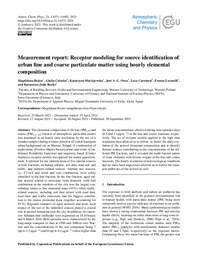Título :
Measurement report: Receptor modeling for source identification of urban fine and coarse particulate matter using hourly elemental composition |
Autor :
Reizer, Magdalena
Calzolai, Giulia 
Maciejewska, Katarzyna 
Garcia Orza, Jose Antonio 
Carraresi, Luca 
Lucarelli, Franco 
Juda-Rezler, Katarzyna  |
Editor :
European Geosciences Union. Copernicus Publications. |
Departamento:
Departamentos de la UMH::Física Aplicada |
Fecha de publicación:
2021 |
URI :
https://hdl.handle.net/11000/35190 |
Resumen :
The elemental composition of the fine (PM2.5) and coarse (PM2.5−10) fraction of atmospheric particulate matter was measured at an hourly time resolution by the use of a streaker sampler during a winter period at a Central European urban background site in Warsaw, Poland. A combination of multivariate (Positive Matrix Factorization) and wind- (Conditional Probability Function) and trajectory-based (Cluster Analysis) receptor models was applied for source apportionment. It allowed for the identification of five similar sources in both fractions, including sulfates, soil dust, road salt, and traffic- and industry-related sources. Another two sources, i.e., Cl-rich and wood and coal combustion, were solely identified in the fine fraction. In the fine fraction, aged sulfate aerosol related to emissions from domestic solid fuel combustion in the outskirts of the city was the largest contributing source to fine elemental mass (44 %), while traffic-related sources, including soil dust mixed with road dust, road dust, and traffic emissions, had the biggest contribution to the coarse elemental mass (together accounting for 83 %). Regional transport of aged aerosols and more local impact of the rest of the identified sources played a crucial role in aerosol formation over the city. In addition, two intensive Saharan dust outbreaks were registered on 18 February and 8 March 2016. Both episodes were characterized by the long-range transport of dust at 1500 and 3000 m over Warsaw and the concentrations of the soil component being 7 (up to 3.5 µg m−3) and 6 (up to 6.1 µg m−3) times higher than the mean concentrations observed during non-episodes days (0.5 and 1.1 µg m−3) in the fine and coarse fractions, respectively. The set of receptor models applied to the high time resolution data allowed us to follow, in detail, the daily evolution of the aerosol elemental composition and to identify distinct sources contributing to the concentrations of the different PM fractions, and it revealed the multi-faceted nature of some elements with diverse origins in the fine and coarse fractions. The hourly resolution of meteorological conditions and air mass back trajectories allowed us to follow the transport pathways of the aerosol as well.
|
Área de conocimiento :
CDU: Ciencias puras y naturales: Física |
Tipo de documento :
info:eu-repo/semantics/article |
Derechos de acceso:
info:eu-repo/semantics/openAccess
Attribution-NonCommercial-NoDerivatives 4.0 Internacional |
DOI :
https://doi.org/10.5194/acp-21-14471-2021 |
Publicado en:
Atmospheric Chemistry and Physics |
Aparece en las colecciones:
Artículos - Física Aplicada
|

 La licencia se describe como: Atribución-NonComercial-NoDerivada 4.0 Internacional.
La licencia se describe como: Atribución-NonComercial-NoDerivada 4.0 Internacional.
.png)